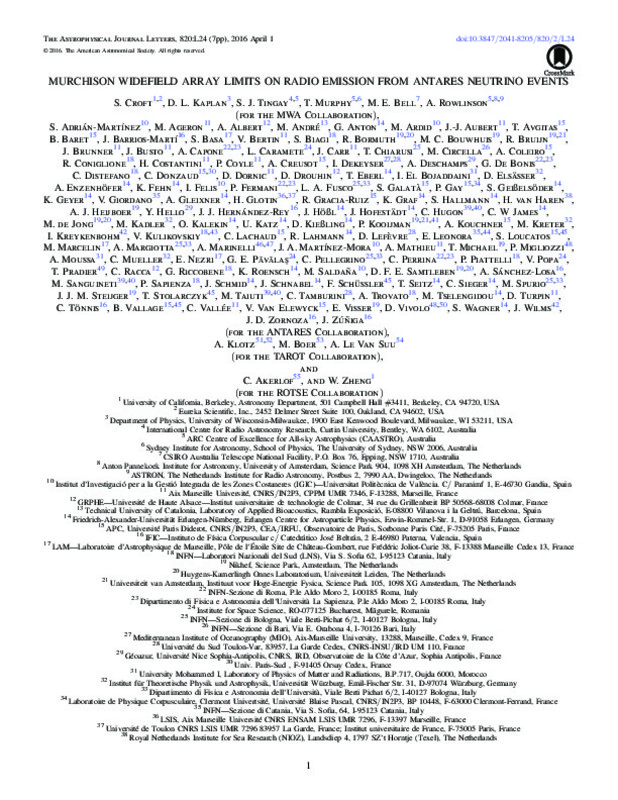|
Resumen:
|
We present a search, using the Murchison Widefield Array (MWA), for electromagnetic (EM) counterparts to two candidate high-energy neutrino events detected by the ANTARES neutrino telescope in 2013 November and 2014 March. ...[+]
We present a search, using the Murchison Widefield Array (MWA), for electromagnetic (EM) counterparts to two candidate high-energy neutrino events detected by the ANTARES neutrino telescope in 2013 November and 2014 March. These events were selected by ANTARES because they are consistent, within 0 degrees.4, with the locations of galaxies within 20 Mpc of Earth. Using MWA archival data at frequencies between 118 and 182 MHz, taken similar to 20. days prior to, at the same time as, and up to a year after the neutrino triggers, we look for transient or strongly variable radio sources that are consistent with the neutrino positions. No such counterparts are detected, and we set a 5 sigma upper limit for low-frequency radio emission of similar to 10(37) erg s(-1) for progenitors at 20 Mpc. If the neutrino sources are instead not in nearby galaxies, but originate in binary neutron star coalescences, our limits place the progenitors at z greater than or similar to 0.2. While it is possible, due to the high background from atmospheric neutrinos, that neither event is astrophysical, the MWA observations are nevertheless among the first to follow up neutrino candidates in the radio, and illustrate the promise of wide-field instruments like MWA for detecting EM counterparts to such events.
[-]
|
|
Agradecimientos:
|
This scientific work makes use of the Murchison Radioastronomy Observatory, operated by CSIRO. We acknowledge the Wajarri Yamatji people as the traditional owners of the Observatory site. Support for the operation of the ...[+]
This scientific work makes use of the Murchison Radioastronomy Observatory, operated by CSIRO. We acknowledge the Wajarri Yamatji people as the traditional owners of the Observatory site. Support for the operation of the MWA is provided by the Australian Government Department of Industry and Science and Department of Education (National Collaborative Research Infrastructure Strategy: NCRIS), under a contract with Curtin University, administered by Astronomy Australia Limited. We acknowledge the iVEC Petabyte Data Store and the Initiative in Innovative Computing and the CUDA Center for Excellence sponsored by NVIDIA at Harvard University. D.L.K. and S.D.C. acknowledge support from the US National Science Foundation (grant AST-1412421). We acknowledge the financial support of the funding agencies: Centre National de la Recherche Scientifique (CNRS), Commissariat a l'enegie atomique et aux energies alternatives (CEA), Commission Europeenne (FEDER fund and Marie Curie Program), Region Ile-de-France (DIM-ACAV), Region Alsace (contrat CPER), Region Provence-Alpes-Cote d'Azur, Departement du Var and Ville de La Seyne-sur-Mer, France; Bundesministerium fur Bildung und Forschung (BMBF), Germany; Istituto Nazionale di Fisica Nucleare (INFN), Italy; Stichting voor Fundamenteel Onderzoek der Materie (FOM), Nederlandse organisatie voor Wetenschappelijk Onderzoek (NWO), the Netherlands; Council of the President of the Russian Federation for Young Scientists and Leading Scientific Schools Supporting Grants, Russia; National Authority for Scientific Research (ANCS), Romania; Ministerio de Ciencia e Innovacion (MICINN), Prometeo of Generalitat Valenciana and MultiDark, Spain; Agence de l'Oriental and CNRST, Morocco. We also acknowledge the technical support of Ifremer, AIM, and Foselev Marine for the sea operation and the CC-IN2P3 for the computing facilities. We gratefully acknowledge financial support from the OCEVU LabEx, France. We thank Nathan Whitehorn and the anonymous referee for helpful comments.
[-]
|









